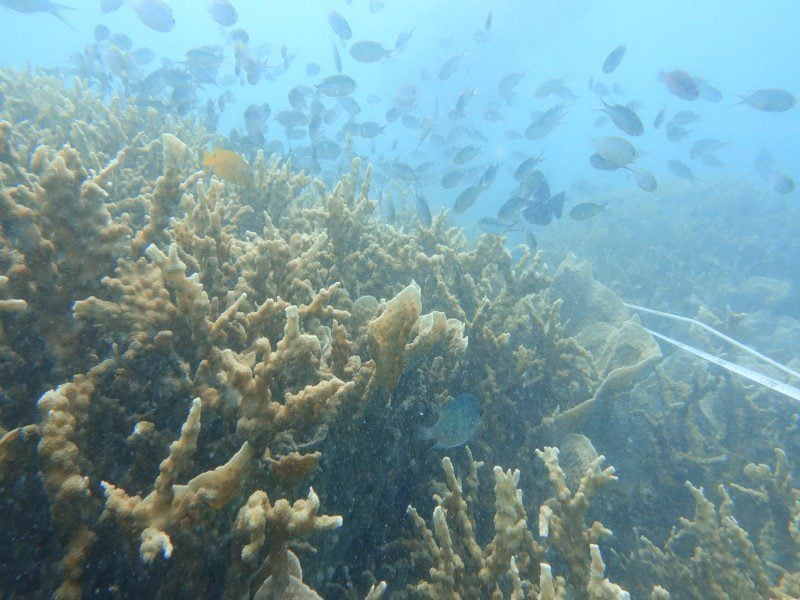Restoring Coral Reefs of Sangiang Island Through Transplantation Technique

Coral Reefs in Sangiang Island, Source: KEHATI.
-
Date:
09 Oct 2023 -
Author:
KEHATI
Almost throughout the Indonesian waters, the condition of coral reefs is categorized as poor. One effort to improve the situation is through transplantation techniques. The coral reefs in Sangiang Island, located in the Sunda Strait, are part of the Corporate Social Responsibility (CSR) of PT. Asahimas, and they have been restoring and rehabilitating the reefs since 2018.
Sangiang Island is categorized as a Nature Tourism Park (TWA) with eco-tourism options, in addition to being a place for fishermen, although fishing activities have decreased. The supervision on Sangiang Island, managed by BBKSDA, has had an impact on better monitoring of fishing activities. The use of bombs for fishing is no longer present due to the advancement of technology, such as mobile phones that can record such illegal activities. The community also becomes more aware of not consuming fish caught using bombs.
According to Toufik Alansar, the Program Manager of Marine Foundation KEHATI, the restoration target is actually for an area of more than 1 hectare but only around 600 m2 has been covered so far. The coral reef restoration on Sangiang Island is a collaboration between PT. Asahimas and KEHATI Foundation. The company, located in Cilegon city, has provided financial support of 500 million rupiah for planting and monitoring activities. Since the start of the restoration project, the coral reef has shown progress towards its ecological function. For the remaining area that has not been addressed, it is hoped that PT. Asahimas will be willing to participate again financially.
In the conservation program for coral reefs on Sangiang Island, KEHATI foundation collaborates exclusively with PT. Asahimas without involving any other CSR efforts. This is done to avoid over claim, and if any other companies are interested in carrying out coral restoration, alternative locations will be sought. PT. Asahimas feels socially responsible and has an interest in restoring and rehabilitating coral reefs on Sangiang Island. The waste from development activities in Cilegon and the coastal area of Banten Island will definitely have an impact on the marine ecosystem of this island. As a result, the damage to the coral reefs in the Sangiang area will directly affect the city of Cilegon. The coastal ecosystem of Sangiang Island acts as a barrier, preventing the wave currents from the Sunda Strait from reaching the city of Cilegon. Moreover, the terrestrial and marine ecosystems of Sangiang Island are among the finest, second only to Ujung Kulon.
Coral reef restoration through transplantation techniques is performed using PVC or cement materials to support the growth of live coral fragments. Another option is stacking them on stone substrates. Despite the challenges posed by strong waves that can cause the fragments to fall and lead to some casualties, there are still some resilient coral frags that manage to survive and naturally regrow. The coral transplantation is carried out using a triangular-shaped mount and a flat table method. Since the waters around Sangiang Island in the Sunda Strait have dangerous currents, the chosen transplantation medium for Sangiang Island is the triangular shape, as it can withstand the powerful downward currents.
This coral reef is a collection of organisms called polyps that attach themselves to a substrate. Each reef contains thousands of polyps. They survive by photosynthesizing. At night, polyps lay eggs and search for a substrate to attach to. Some also gather together to form their own reef. Coral reefs have a symbiotic relationship with fish that feed on the algae growing on the reef. The habitat of coral reef ecosystems ranges from 0.5 to 100 meters deep. The 0.5-meter height is submerged during high tide but exposed during low tide. The growth of coral offspring relies on sunlight penetrating the depths of the ocean for photosynthesis to occur.
As one of the three coastal ecosystems, alongside mangroves and seagrass beds, coral reefs serve as wave breakers. The first line of defense against the waves, coral reefs reduce the energy of the waves before they reach the mangroves. While all three coastal ecosystems are crucial, the KEHATI Foundation and PT. Asahimas prioritize the conservation of coral reefs as the front line and mangroves as the ecosystem that safeguards the rear. Seagrass beds, on the other hand, primarily serve as a food source for marine life and a carbon sink, in addition to mangroves.
Coral reefs are highly susceptible to climate change. When wave currents are affected by excessively high temperatures, coral reefs undergo bleaching. They thrive when the air temperature is suitable for their growth. Furthermore, when the Crown-of-Thorns Starfish or Acanthaster planci feed on coral, it also leads to bleaching. In Pulau Sangiang, coral bleaching is largely caused by Acanthaster planci.
“You can tell if coral is bleaching due to high temperatures, Crown-of-Thorns Starfish, or cyanide used for fishing,” added Toufik.
The progress of the transplantation activity is getting better as the corals have developed associations with other marine organisms like fish. This has caught the attention of tourists, turning coral reef ecotourism into a new and popular destination. Previously, the location in that area was not very good, but since the transplantation, the number of corals has significantly increased. The coral quality in the waters surrounding Sangiang Island was poor before the transplantation took place. Now, coral fragments have grown extensively, forming long, branching structures. The coral reef damage in Pulau Sangiang was caused by unsustainable fishing practices, such as using bombs, and natural factors like earthquakes, waves, and low tides that left the coral exposed and susceptible to deterioration. The transplantation activity aims to accelerate the natural restoration process of the coral reef ecosystem.
LVListyo (Tim Penulis KEHATI)
